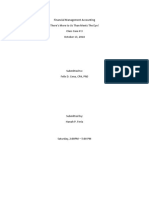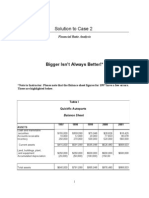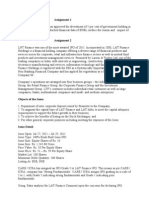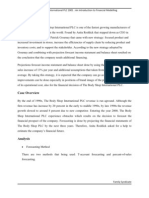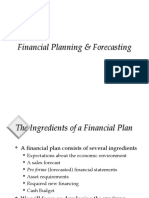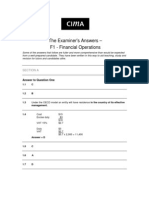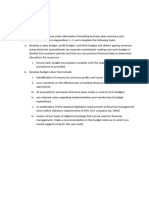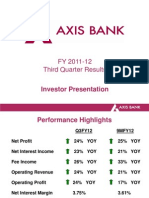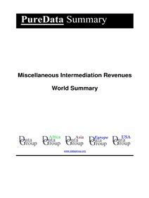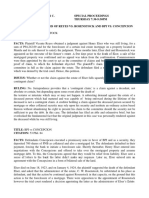2 Just For FEET Case Analysis REWRITE
2 Just For FEET Case Analysis REWRITE
Uploaded by
Juris Renier MendozaCopyright:
Available Formats
2 Just For FEET Case Analysis REWRITE
2 Just For FEET Case Analysis REWRITE
Uploaded by
Juris Renier MendozaOriginal Title
Copyright
Available Formats
Share this document
Did you find this document useful?
Is this content inappropriate?
Copyright:
Available Formats
2 Just For FEET Case Analysis REWRITE
2 Just For FEET Case Analysis REWRITE
Uploaded by
Juris Renier MendozaCopyright:
Available Formats
ACCT 3596: Auditing
2011
Just For FEET, Inc.
Case Analysis: Case 1.2 #1-3, 5
Beka Vinogradov
Seat #1
1 Beka Vinogradov
ACCT 3596: Case Analysis
#1. Common-Sized Balance Sheets.
Just for FEET, Inc.
Balance Sheet
Years ending Jan 31st
1996 1997 1998
Current Assets:
Cash & Equivalents 36.93% 18.40% 1.80%
Marketable Securities AFS 9.04% 0.00% 0.00%
Accounts Receivable 1.74% 3.53% 2.74%
Inventory 35.47% 45.97% 58.01%
Other Current Assets 0.56% 1.50% 2.65%
Total Current Assets 83.75% 69.40% 65.20%
Property & Equipment, net 14.61% 21.08% 23.29%
Goodwill,
net
0.00% 8.05% 10.31%
Other 1.64% 1.46% 1.19%
Total Assets 100.00% 100.00% 100.00%
Current Liabilities:
Short-Term Borrowings 26.61% 20.22% 0.00%
Accounts Payable 10.35% 11.41% 14.55%
Accrued Expenses 1.46% 2.07% 3.60%
Income Taxes Payable 0.11% 0.30% 0.13%
Current Maturities of LT
Debt
0.56% 0.72% 0.96%
Total Current Liabilities 39.09% 34.73% 19.25%
LT Debt & Obligations 2.76% 5.48% 33.51%
Total Liabilities 41.85% 40.21% 52.75%
Shareholders' Equity:
Common Stock 0.00% 0.00% 0.00%
Paid-In Capital 50.69% 48.76% 36.20%
Retained Earnings 7.47% 11.03% 11.04%
Total Shareholders'
Equity
58.15% 59.79% 47.25%
Total Liabilities & SH'
Equity
100.00% 100.00% 100.00%
2 Beka Vinogradov
ACCT 3596: Case Analysis
#1. Common-Sized Income Statements.
Just for FEET, Inc.
Income Statement
Years ending Jan 31st
1996 1997 1998
Net Sales
100.00% 100.00% 100.00%
Cost of
Sales
57.54% 58.46% 58.38%
Gross Profit 42.46% 41.54% 41.62%
Other Revenues 0.23% 0.23% 0.17%
Operating Expenses:
Store Operating 27.04% 29.18% 30.01%
Store Opening Costs 4.38% 1.41% 1.76%
Amortization of
Intangibles
0.07% 0.25% 0.27%
General &
Administrative
3.07% 3.77% 3.14%
Total Operating
Expenses
34.57% 34.60% 35.18%
Operating Income 8.12% 7.17% 6.61%
Interest Expense -0.32% -0.30% -1.04%
Interest Income 1.85% 0.29% 0.02%
EBIT & Acct. Principle 9.65% 7.15% 5.59%
Provision for Income Taxes 3.43% 2.68% 2.15%
Earnings prior to Acct. Principle 6.22% 4.47% 3.44%
Prior Year Acct. Principle -0.80% 0.00% 0.00%
Net Earnings 5.43% 4.47% 3.44%
3 Beka Vinogradov
ACCT 3596: Case Analysis
#1. Key liquidity, solvency, activity, and profitability ratios (1997, 1998).
1997 1998
$ 172,746 $ 82,490
$ 146,914 $ 155,706
1.1758308 0.5297805 Cash Ratio
$ 179,299 $ 98,330
$ 146,914 $ 155,706
1.2204351 0.6315107 Quick Ratio
$ 314,743 $ 311,167
$ 146,914 $ 155,706
2.1423622 1.9984265 Current Ratio
$ 256,397 $ 478,638
$ 6,553 $ 15,840
39.12666 30.217045 A/R Turnover
365 365
39.12666 30.217045
9.3286778 12.079275
Days to Collect
Receivables
$ 147,526 $ 279,816
$ 133,323 $ 206,128
1.1065308 1.3574866 Inventory Turnover
365 365
1.1065308 1.3574866
329.85979 268.87926 Days to Sell Inventory
$ 157,278 $ 180,268
$ 218,556 $ 268,084
0.7196233 0.672431 Debt to Equity
$ 20,825 $ 34,296
$ (832) $ (1,446)
-25.030048 -23.717842 Times Interest Earned
4 Beka Vinogradov
ACCT 3596: Case Analysis
$ 13,919 $ 21,403
? ?
$ 37
EPS
$ 108,871 $ 198,822
$ 256,397 $ 478,638
0.4246189 0.4153912 Gross Profit %
$ 20,825 $ 34,296
$ 256,397 $ 478,638
0.0812217 0.0716533 Profit Margin
$ 24,743 $ 34,220
$ 375,834 $ 448,352
0.0658349 0.076324 Return on Assets
$ 24,743 $ 34,220
$ 218,556 $ 268,084
0.1132113 0.1276466
Return on Common
Equity
#1. High-risk financial statement items.
Based on the information given in the case and the data calculated (above), there are
multiple high-risk financial statement items for the 1998 audit of Just for FEET, specifically
regarding account balances and presentations and disclosures. Notably, inventory valuation,
which increased from 35.47% of total assets in 1996 to 58.01% in 1998, and the accuracy and
allocation of vendor allowances were marked as the highest risk areas. With FEET's use of
creative accounting, accuracy and classification of transactions/events must be monitored as
well. While the calculation of store opening costs fluctuated, store operating costs saw a gross
increase - from $69,329 in 1996 to $232,505 in 1998.
5 Beka Vinogradov
ACCT 3596: Case Analysis
#2. Internal Control Risks; audit planning decisions.
Some internal control risks common among large, high-volume retail stores include
dealing with inherent limitations and potential fraud. Even if a well-designed internal control
system is in place, the employees using it are ultimately the deciding factors in its effectiveness.
For example, management may instruct an employee or easily-influenced executive (of another
company) to alter information or confirmations or multiple employees may conspire to steal
assets or misstate records (collusion; misappropriation of assets).
#3. Inherent Risk Factors; audit planning decisions.
Businesses that face extreme competition are susceptible to many inherent risk factors
the measurement of the auditors assessment of the likelihood that there are material
misstatements in an account balance before considering the effectiveness of internal control.
Complex valuation issues and related party transactions are two such factors that would affect
audit planning decisions.
Valuation issues may lead the audit team to request more evidence, if they choose to
accept the audit at all. Risks such as inventory turnover leading to potential misstatements of
inventory, costs of goods sold, or obsolescence of inventory may influence the audit firms
decision to hire outside specialists to assist in the audit. Another inherent risk factor, client
business risk (competitive advantage), would further emphasize the need to understand the
clients industry in the audit planning process.
6 Beka Vinogradov
ACCT 3596: Case Analysis
#5. Affected parties; how would you have responded?
There are many parties involved which would be affected by the decision. Both Thomas
Shine and Reebok, Just for FEET executives and employees, Deloitte & Touche, as well as all
public shareholders/investors would have been affected by Just for FEETs decision to commit
fraud. With complying executives of vendor firms, these agents are further susceptible to the
negative repercussions of Just for FEETs fraudulent behavior.
I would have said no to Don-Allen Ruttenberg if asked to send a false confirmation.
Illegality aside, I would be risking my reputation, five years in federal prison, and a $250,000
fine to do so. Furthermore, I feel Shines actions did absolutely nothing to benefit himself or his
company. There was no gain to Shine or Reebok in consenting with Ruttenbergs request so I
have trouble understanding why he agreed to it. The case states that FEET had a significant
amount of economic leverage over the vendor executives, but doesnt really explain why. This
is a prime example of why fraud occurs (see: fraud triangle): the pressures (on Shine) to
consent to FEETs demands, as well as the opportunities available and
attitudes/rationalization of top management/Ruttenberg to commit.
You might also like
- Carter's LBO ModelDocument1 pageCarter's LBO ModelNoah100% (2)
- Class Case 3 - There's More To Us Than Meets The EyeDocument11 pagesClass Case 3 - There's More To Us Than Meets The EyeHannahPojaFeria50% (2)
- XLS092-XLS-EnG Tire City - RaghuDocument49 pagesXLS092-XLS-EnG Tire City - RaghuSohini Mo BanerjeeNo ratings yet
- Why Does Juan Garcia Have A Drinking Problem?Document17 pagesWhy Does Juan Garcia Have A Drinking Problem?tdavis1986No ratings yet
- Assignment Brief Mn2415 2023 24Document7 pagesAssignment Brief Mn2415 2023 24Haseeb DarNo ratings yet
- Solution To Case 2: Bigger Isn't Always Better!Document9 pagesSolution To Case 2: Bigger Isn't Always Better!Muhammad Iqbal Huseini0% (1)
- Chapter 1Document6 pagesChapter 1sugitahNo ratings yet
- Accounts AssignmentDocument7 pagesAccounts AssignmentHari PrasaadhNo ratings yet
- Accounts Case StudyDocument7 pagesAccounts Case Studyshivam tripathiNo ratings yet
- Attachments To: Mid-Term ExamDocument7 pagesAttachments To: Mid-Term Examveda20No ratings yet
- Financial Statement AnalysisDocument18 pagesFinancial Statement AnalysisSaema JessyNo ratings yet
- Short and Long-Term: On Balance Sheet DebtDocument8 pagesShort and Long-Term: On Balance Sheet DebtNitin KumarNo ratings yet
- First Quarter 2008 Earnings Review: April 18, 2008Document24 pagesFirst Quarter 2008 Earnings Review: April 18, 2008Mark ReinhardtNo ratings yet
- Body ShopDocument8 pagesBody ShopShopan J. Endrawan75% (4)
- CH 2Document62 pagesCH 2ahodhodNo ratings yet
- Itc LTD Financial Analysis: Group 4Document20 pagesItc LTD Financial Analysis: Group 4Kanav ChaudharyNo ratings yet
- Assignments Semester IDocument13 pagesAssignments Semester Idriger43No ratings yet
- ITC Financial ReportDocument15 pagesITC Financial ReportigmortalgamingNo ratings yet
- Answr Test FmaDocument11 pagesAnswr Test Fmanaveensharma.8847No ratings yet
- Multi Tech Case AnalysisDocument4 pagesMulti Tech Case AnalysissimplymesmNo ratings yet
- 1 - Nike Cost of CapitalDocument8 pages1 - Nike Cost of CapitalJayzie LiNo ratings yet
- Financial Planning & ForecastingDocument23 pagesFinancial Planning & ForecastingRanjan SingNo ratings yet
- L.A. Gear Mini Case StudyDocument3 pagesL.A. Gear Mini Case StudySenthu JeganathanNo ratings yet
- Ratio Analysis of L&T InfotechDocument36 pagesRatio Analysis of L&T Infotechrajwindernijjar1100% (1)
- Clarkson Lumber Company (7.0)Document17 pagesClarkson Lumber Company (7.0)Hassan Mohiuddin100% (1)
- Introduction L&T FinalDocument31 pagesIntroduction L&T Finaltushar kumarNo ratings yet
- Fiscal Year Is January-December. All Values USD Millions.: AssetsDocument29 pagesFiscal Year Is January-December. All Values USD Millions.: AssetsHubert Luis Madariaga ManyaNo ratings yet
- Vertical and Horizontal Analysis of PidiliteDocument12 pagesVertical and Horizontal Analysis of PidiliteAnuj AgarwalNo ratings yet
- CHAP - 02 - Financial Statements of BankDocument49 pagesCHAP - 02 - Financial Statements of BankTú NguyễnNo ratings yet
- F1 May 2011 AnswersDocument11 pagesF1 May 2011 AnswersmavkaziNo ratings yet
- Asics CorporationDocument6 pagesAsics Corporationasadguy2000No ratings yet
- Chpater 4 SolutionsDocument13 pagesChpater 4 SolutionsAhmed Rawy100% (1)
- CHAP - 02 - Financial Statements of BankDocument72 pagesCHAP - 02 - Financial Statements of BankTran Thanh NganNo ratings yet
- FMDocument233 pagesFMparika khannaNo ratings yet
- BSBFIM601 Task 1Document10 pagesBSBFIM601 Task 1Kitpipoj PornnongsaenNo ratings yet
- LEITI 2nd Reconciliation ReportDocument112 pagesLEITI 2nd Reconciliation ReportLiberiaEITINo ratings yet
- Final Report (Renata Limited) RYA FIN440Document51 pagesFinal Report (Renata Limited) RYA FIN440Prince AhmedNo ratings yet
- Analyzing Bank Performance: Using The UbprDocument70 pagesAnalyzing Bank Performance: Using The UbpraliNo ratings yet
- Dupont AnalysisDocument5 pagesDupont AnalysisTECH BABANo ratings yet
- FY 2011-12 Third Quarter Results: Investor PresentationDocument34 pagesFY 2011-12 Third Quarter Results: Investor PresentationshemalgNo ratings yet
- Coca Cola Financial Statements 2008Document75 pagesCoca Cola Financial Statements 2008James KentNo ratings yet
- Zhuo Hu 684 Part 3Document32 pagesZhuo Hu 684 Part 3huzhuoNo ratings yet
- ITC Financial AnalysisDocument21 pagesITC Financial AnalysisDeepak ChandekarNo ratings yet
- STP 1Q12 Earnings Deck NewDocument19 pagesSTP 1Q12 Earnings Deck NewEnergiemediaNo ratings yet
- 2020 - Midland - Student SpreadsheetDocument14 pages2020 - Midland - Student Spreadsheetvasu goswamiNo ratings yet
- Apple 2014 Q2Document54 pagesApple 2014 Q2ikiqNo ratings yet
- Goldman Sachs-opinion-The Procter & Gamble CompanyDocument37 pagesGoldman Sachs-opinion-The Procter & Gamble CompanyUnnikrishnan SNo ratings yet
- BAM Balyasny 200809Document6 pagesBAM Balyasny 200809jackefellerNo ratings yet
- Macys 2011 10kDocument39 pagesMacys 2011 10kapb5223No ratings yet
- Task 1 Finance ManagementDocument17 pagesTask 1 Finance Managementraj ramukNo ratings yet
- Boeing: I. Market InformationDocument21 pagesBoeing: I. Market InformationMohamed Ali SalemNo ratings yet
- First Resources: Singapore Company FocusDocument7 pagesFirst Resources: Singapore Company FocusphuawlNo ratings yet
- The Valuation of Digital Intangibles: Technology, Marketing and InternetFrom EverandThe Valuation of Digital Intangibles: Technology, Marketing and InternetNo ratings yet
- Rogues of Wall Street: How to Manage Risk in the Cognitive EraFrom EverandRogues of Wall Street: How to Manage Risk in the Cognitive EraNo ratings yet
- Audit Risk Alert: General Accounting and Auditing Developments 2018/19From EverandAudit Risk Alert: General Accounting and Auditing Developments 2018/19No ratings yet
- Measuring Business Interruption Losses and Other Commercial Damages: An Economic ApproachFrom EverandMeasuring Business Interruption Losses and Other Commercial Damages: An Economic ApproachNo ratings yet
- The Controller's Function: The Work of the Managerial AccountantFrom EverandThe Controller's Function: The Work of the Managerial AccountantRating: 2 out of 5 stars2/5 (1)
- Miscellaneous Intermediation Revenues World Summary: Market Values & Financials by CountryFrom EverandMiscellaneous Intermediation Revenues World Summary: Market Values & Financials by CountryNo ratings yet
- J.K. Lasser's Small Business Taxes 2021: Your Complete Guide to a Better Bottom LineFrom EverandJ.K. Lasser's Small Business Taxes 2021: Your Complete Guide to a Better Bottom LineNo ratings yet
- Truth in Lending ActDocument7 pagesTruth in Lending ActJuris Renier Mendoza100% (1)
- Mondragon Vs SolaDocument1 pageMondragon Vs SolaJuris Renier MendozaNo ratings yet
- Diaz Vs VirataDocument1 pageDiaz Vs VirataJuris Renier MendozaNo ratings yet
- Bank of Commerce Vs RPN Case DigestDocument2 pagesBank of Commerce Vs RPN Case DigestJuris Renier Mendoza100% (3)
- Trust Receipts Law PD 115 NotesDocument39 pagesTrust Receipts Law PD 115 NotesJuris Renier MendozaNo ratings yet
- Lao VS lAODocument2 pagesLao VS lAOJuris Renier MendozaNo ratings yet
- Hala Ka DihaDocument2 pagesHala Ka DihaJuris Renier MendozaNo ratings yet
- Written Report 5Document11 pagesWritten Report 5Juris Renier MendozaNo ratings yet
- Ra 9048Document3 pagesRa 9048Juris Renier MendozaNo ratings yet
- Batch 3 CompilationDocument12 pagesBatch 3 CompilationJuris Renier MendozaNo ratings yet
- Hdata Lee Vs IlaganDocument2 pagesHdata Lee Vs IlaganJuris Renier MendozaNo ratings yet
- Negligence in General Full Text CasesDocument39 pagesNegligence in General Full Text CasesJuris Renier MendozaNo ratings yet
- AmazingnessDocument15 pagesAmazingnessJuris Renier MendozaNo ratings yet
- Huang Vs Philippine HoteliersDocument2 pagesHuang Vs Philippine HoteliersJuris Renier MendozaNo ratings yet
- Comparative - Reyes Vs Rosenstock and Bpi Vs ConcepcionDocument3 pagesComparative - Reyes Vs Rosenstock and Bpi Vs ConcepcionJuris Renier MendozaNo ratings yet
- 10 Banco Filipino vs. Monetary Board People vs. InvencionDocument3 pages10 Banco Filipino vs. Monetary Board People vs. InvencionJuris Renier MendozaNo ratings yet
- Sec Case No. 1375Document47 pagesSec Case No. 1375Juris Renier MendozaNo ratings yet
- Cardinal Principles SuccessionDocument2 pagesCardinal Principles SuccessionJuris Renier MendozaNo ratings yet
- Bar Exam Question: Iren G. Pepito Certiorari Mendez v. People, 726 SCRA 480Document3 pagesBar Exam Question: Iren G. Pepito Certiorari Mendez v. People, 726 SCRA 480Juris Renier MendozaNo ratings yet
- For ReceivingDocument1 pageFor ReceivingJuris Renier MendozaNo ratings yet
- LIST OF 40+ AI Marketing ToolsDocument15 pagesLIST OF 40+ AI Marketing ToolsAbhrajyoti ChowdhuryNo ratings yet
- Isu Applied StratagemDocument10 pagesIsu Applied Stratagemgizzy9dillespieNo ratings yet
- Car RentalDocument36 pagesCar RentalKeerthi Vasan LNo ratings yet
- Environmental and Socio-Economic Aspect Study On Rangamati (Kaptai Lake & Surrounding Area)Document20 pagesEnvironmental and Socio-Economic Aspect Study On Rangamati (Kaptai Lake & Surrounding Area)RuhitAhmedRuhit100% (1)
- Pengaruh Desinfeksi Dengan Teknik SprayDocument6 pagesPengaruh Desinfeksi Dengan Teknik SpraySartinah 46No ratings yet
- Topic 3 ExamplesDocument9 pagesTopic 3 ExamplesJessica MccormickNo ratings yet
- Lesson 2.4Document2 pagesLesson 2.4Rolando EnodioNo ratings yet
- Ahscc 2019 BrochureDocument6 pagesAhscc 2019 BrochureAjay JhaNo ratings yet
- JRC127468 - 01-Steel Making-DecarbDocument59 pagesJRC127468 - 01-Steel Making-Decarbropi.saraNo ratings yet
- Abstract of Sealed of CanvassDocument13 pagesAbstract of Sealed of CanvassReymart BorresNo ratings yet
- Main - Group 05Document131 pagesMain - Group 05lokezhengyan22No ratings yet
- The Courage To Teach SummaryDocument2 pagesThe Courage To Teach SummaryOdete Alhadas Salgado100% (1)
- Brown and Levinson's Politeness TheoryDocument24 pagesBrown and Levinson's Politeness TheorykristineoridoNo ratings yet
- IAFS 2023 Sydney Declaration - 18 May 2021Document2 pagesIAFS 2023 Sydney Declaration - 18 May 2021alinatNo ratings yet
- Integrative Course - Hydraulics 2Document5 pagesIntegrative Course - Hydraulics 2Agerico Funelas100% (1)
- Mechanisms of Machinery Blue Print ObjectivesDocument9 pagesMechanisms of Machinery Blue Print Objectiveskidusabeje7No ratings yet
- NIFT 2021 - PracticeDocument2 pagesNIFT 2021 - Practicetanaya.rpsNo ratings yet
- 001 상품기술서 락토저분자콜라겐 (박스) 20210730Document2 pages001 상품기술서 락토저분자콜라겐 (박스) 20210730Kay JeongNo ratings yet
- 4 5triangle Congruence ASA AAS HLDocument28 pages4 5triangle Congruence ASA AAS HLMyca Antonette Yza CordovaNo ratings yet
- WAG MO NA SANA CHORDS by Parokya Ni Edgar at Ultimate-GuitarDocument1 pageWAG MO NA SANA CHORDS by Parokya Ni Edgar at Ultimate-Guitarartemis SpecterNo ratings yet
- Yavakalapi Sutta CommentaryDocument8 pagesYavakalapi Sutta CommentaryRaj NarayananNo ratings yet
- Conflict Management: Technical Report WritingDocument24 pagesConflict Management: Technical Report WritingUbaidullah GhaffaryNo ratings yet
- F. Sionil Jose's "Vibora" (A Report)Document19 pagesF. Sionil Jose's "Vibora" (A Report)Zeus David Arjona0% (1)
- Memorandum ExampleDocument4 pagesMemorandum ExampleJhamyr Joi Camantigue MastriliNo ratings yet
- Ancient India JusticeDocument6 pagesAncient India JusticeSimran AroraNo ratings yet
- ROI FormDocument3 pagesROI FormKaden MaysNo ratings yet
- Variable Load AnalysisDocument15 pagesVariable Load AnalysisNicole Mae AllosadaNo ratings yet
- EAS Vocabulary U1 Sample PDFDocument8 pagesEAS Vocabulary U1 Sample PDFstorming25No ratings yet
- Adfl8412 MoDocument66 pagesAdfl8412 MotarahnamNo ratings yet

